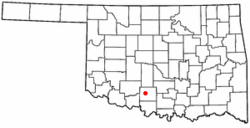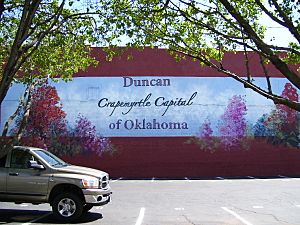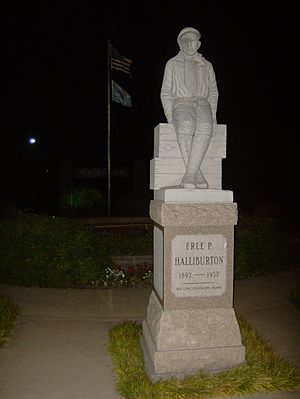Duncan, Oklahoma facts for kids
Quick facts for kids
Duncan, Oklahoma
|
|
|---|---|
|
City
|
|
 |
|

Location of Duncan, Oklahoma
|
|
| Country | United States |
| State | Oklahoma |
| County | Stephens |
| Area | |
| • Total | 47.77 sq mi (123.73 km2) |
| • Land | 42.91 sq mi (111.13 km2) |
| • Water | 4.87 sq mi (12.61 km2) |
| Elevation | 1,122 ft (342 m) |
| Population
(2010)
|
|
| • Total | 23,431 |
| • Estimate
(2019)
|
22,344 |
| • Density | 520.75/sq mi (201.07/km2) |
| Time zone | UTC−6 (Central (CST)) |
| • Summer (DST) | UTC−5 (CDT) |
| ZIP codes |
73533-73599
|
| Area code(s) | 580 |
| FIPS code | 40-21900 |
| GNIS feature ID | 1092291 |
| Website | cityofduncan.com |
Duncan is a city and county seat of Stephens County, Oklahoma, United States. The population was 22,310 at the 2020 census. Its main claim to fame is as the birthplace of the Halliburton Corporation. Erle P. Halliburton established the New Method Oil Well Cementing Company in 1919. Halliburton maintains seven different complexes in Duncan plus an employee recreational park, but the corporate offices relocated first to Dallas and later to Houston.
Centrally located in Stephens County, Duncan became the county seat after Oklahoma achieved statehood in 1907. Oil wells opened in Stephens County in 1918 and led to rapid development. Cotton was a dominant crop until the Dust Bowl brought its decline, but cattle remains an important part of the economy. The Chisholm Trail passed to the east of Duncan prior to the town's founding, which is home to the Chisholm Trail Heritage Center.
Contents
History

The Chisholm Trail passed to the east of Duncan prior to the town's founding. An estimated 9,800,000 Longhorn cattle were herded up the trail between Texas and Abilene, Kansas during its existence. After learning that an extension of the Chicago, Rock Island and Pacific Railroad was being built from Kansas to Texas, Scotsman William Duncan brought his wife, parents, and other relatives and created a trading post situated at the intersection of the north-south Chisholm Trail and the east-west military passage between Fort Arbuckle and Fort Sill. The first train arrived on June 27, 1892; that date is considered the official birth date of the town.
Many of the city's first buildings were woodframe, but were replaced by sandstone and brick structures after natural disasters destroyed them. Four fires in 1901 burned down several buildings.
Centrally located in Stephens County, Duncan became the county seat after Oklahoma achieved statehood in 1907. As a compromise between residents of the northern and southern parts of the county, the county courthouse was located in the middle of Duncan's Main Street, half of it in the northern part of the city and county and half in the southern. Main Street made a wide circle around it on both ends.
Oil wells opened in Stephens County in 1918 and led to rapid development in Duncan. Shacks were prohibited immediately following the opening of the wells and other regulations were also put in place to channel the growth in an organized manner.
Several Tudor Revival style homes were built in the 1930s. Works Progress Administration projects meant to rebuild the economy after the Great Depression resulted in a public library, a senior high school, a stadium, a pool, a school and auditorium for the black community, an armory, and numerous bridges and sidewalks.
Duncan expanded its city limits during an economic surge brought on by World War II. Towards the end of this period, the downtown area began to see a decline.
Geography
Duncan is located at 34°31′0″N 97°56′58″W / 34.51667°N 97.94944°W (34.516619, −97.949377). The town is situated approximately 30 miles East of Lawton
It is on U.S. Highway 81.
According to the United States Census Bureau, the city has a total area of 46.0 square miles (119 km2), of which 38.8 square miles (100 km2) is land and 7.2 square miles (19 km2) (15.67%) is water.
Duncan is known for crepe myrtle trees, Oklahoma prairie and rich farmland. State lawmakers designated the city as Oklahoma's official "Crepe Myrtle Capital". Oklahoma's grasslands are made up of shortgrass, mixed-grass and tallgrass prairie. The city is part of the Great Plains and has four lakes.
Duncan receives 34 inches of rain per year, but only five inches of snowfall. The city also receives an average of 241 sunny days per year. It lies 1,128 feet above sea level.
Duncan's buildings listed on the National Register of Historic Places include the Johnson Hotel and Boarding House, the Chrislip House, the Duncan Armory, the Patterson Hospital and the old Duncan library. The downtown area lies between Walnut and Willow avenues, from the railroad tracks to State Highway 81.
Climate
| Climate data for Duncan, Oklahoma | |||||||||||||
|---|---|---|---|---|---|---|---|---|---|---|---|---|---|
| Month | Jan | Feb | Mar | Apr | May | Jun | Jul | Aug | Sep | Oct | Nov | Dec | Year |
| Record high °F (°C) | 84 (29) |
88 (31) |
97 (36) |
96 (36) |
99 (37) |
106 (41) |
110 (43) |
110 (43) |
108 (42) |
101 (38) |
90 (32) |
88 (31) |
110 (43) |
| Average high °F (°C) | 52 (11) |
57 (14) |
65 (18) |
76 (24) |
82 (28) |
90 (32) |
95 (35) |
96 (36) |
89 (32) |
78 (26) |
64 (18) |
55 (13) |
75 (24) |
| Average low °F (°C) | 29 (−2) |
33 (1) |
40 (4) |
51 (11) |
59 (15) |
68 (20) |
71 (22) |
71 (22) |
64 (18) |
53 (12) |
39 (4) |
32 (0) |
51 (11) |
| Record low °F (°C) | −8 (−22) |
−3 (−19) |
2 (−17) |
26 (−3) |
34 (1) |
49 (9) |
55 (13) |
56 (13) |
36 (2) |
26 (−3) |
14 (−10) |
5 (−15) |
−8 (−22) |
| Average precipitation inches (mm) | 1.4 (36) |
1.8 (46) |
2.0 (51) |
3.0 (76) |
6.4 (160) |
4.5 (110) |
2.7 (69) |
2.4 (61) |
2.5 (64) |
3.4 (86) |
1.5 (38) |
1.5 (38) |
33.1 (835) |
| Average snowfall inches (cm) | 2 (5.1) |
2.2 (5.6) |
1 (2.5) |
0.3 (0.76) |
— | — | — | — | — | — | — | 1.5 (3.8) |
7 (18) |
| Average rainy days | 3.5 | 4.3 | 4.8 | 6.1 | 7.6 | 7.3 | 5.2 | 4.8 | 4.3 | 5.5 | 2.9 | 3.8 | 60.1 |
| Average relative humidity (%) | 70 | 67 | 61 | 60 | 68 | 65 | 63 | 58 | 58 | 63 | 63 | 66 | 64 |
| Source 1: weather.com | |||||||||||||
| Source 2: Weatherbase.com | |||||||||||||
Demographics
| Historical population | |||
|---|---|---|---|
| Census | Pop. | %± | |
| 1900 | 1,164 | — | |
| 1910 | 2,477 | 112.8% | |
| 1920 | 3,463 | 39.8% | |
| 1930 | 8,363 | 141.5% | |
| 1940 | 9,207 | 10.1% | |
| 1950 | 15,325 | 66.4% | |
| 1960 | 20,009 | 30.6% | |
| 1970 | 19,718 | −1.5% | |
| 1980 | 22,517 | 14.2% | |
| 1990 | 21,732 | −3.5% | |
| 2000 | 22,505 | 3.6% | |
| 2010 | 23,431 | 4.1% | |
| 2019 (est.) | 22,344 | −4.6% | |
| Sources: | |||
2010 census
At the 2010 census, there were 23,431 people and 9,535 households residing in the city. There were 11,064 housing units. The racial makeup of the city was 82.3% White, 3.3% African American, 4.7% Native American, and 5.0% from two or more races. Hispanic or Latino of any race were 8.9% of the population.
The average household size was 2.41. The age distribution was 23.8% under the age of 18 and 17.9% 65 or older. The median household income was $39,683. The per capita income for the city was $22,230. About 16% of the population were below the poverty line.
Arts and culture
Duncan is home to the Chisholm Trail Heritage Center. The Stephens County Historical Museum contains displays and artifacts from the land run and early settlement in the area.
The city holds an annual county fair and top-rated livestock events year round. Other annual events include the Chisholm Trail Arts Council's Art Walk, Trail Dance Film Festival, Cruizin' the Chisholm Trail Car and Motorcycle Show, the Chisholm Trail Stampede, The Dehydrator bicycle race/ride [1], Summerfest with the World's Largest Garage Sale and the Western Spirit Celebration.
Economy
Duncan once adopted the slogan, "The Buckle on the Oil Belt". Its main claim to fame is as the birthplace of the Halliburton Corporation. Erle P. Halliburton perfected a new method of cementing wells, making oil production much easier and more profitable, and established the New Method Oil Well Cementing Company in 1919. He died in 1957, at which time the company had 201 offices in 22 states and 20 foreign countries. Halliburton maintains seven different complexes in Duncan plus an employee recreational park, but the corporate offices relocated first to Dallas and later to Houston.
Halliburton operates the Halliburton Technology Center in Duncan. In 2010 Halliburton announced that 150 jobs in the center will move to Houston over the following two years.
Agriculture has always played a part in Duncan's economy. Cotton was a dominant crop until the Dust Bowl brought about a reduction in its role. Cattle remains an important part of Duncan's economy.
The city has been home to a number of banks and doctors since its early settlement and both continue to be well represented today.
Education
- Duncan Public Schools is Duncan's school district
- Red River Technology Center is the city's vocational education institution.
- Cameron University also has a branch in Duncan.
Transportation
Duncan is served by U.S. Route 81 and State Highway 7. State Highway 29 runs just north of town, and State Highway 53 runs just south of town.
Halliburton Field (KDUC; FAA ID: DUC), owned by the City of Duncan and located two miles south, has a paved 6326’ x 100’ runway. The airport hosted commercial air service from Central Airlines in the 1960s.
Notable people
- Ben Aldridge (1926–1956) – professional football player
- Jari Askins (born 1953) – Oklahoma State Representative; Lt. Governor of Oklahoma
- Gary Austin (1941–2017) – actor and teacher of improvisational theater
- Larry Austin (born 1930) – composer and music educator
- Hoyt Axton (1938–1999) – country music singer-songwriter
- Ralph Mooney (1928-2011) - country music steel guitarist and songwriter
- Bryce Davis (born 1989) – professional football player
- Donald Grantham (born 1947) – composer and music educator
- Quinn Grovey – college football player and sportscaster
- Erle P. Halliburton (1892–1957) – founder, Halliburton Oil Well Cementing Company
- Joe Hassler (1905–1971) – professional baseball player
- Hall Haynes (1928–1988) – professional football player
- Jean Speegle Howard (1927–2000) – actress
- Rance Howard (1928–2017) – actor
- Ron Howard (born 1954) – actor, director, producer
- Jeane Kirkpatrick (1926–2006) – United States Ambassador to the United Nations
- Ned Pettigrew (1881–1952) – professional baseball player and manager
- Jackie Sherrill (born 1943) – former college football head coach
- Betty Lou Shipley (born 1931) - Poet Laureate of Oklahoma (1997-1998)
- Phil Stephenson (born 1945) – member of the Texas House of Representatives from Wharton, Texas
- Basil Wilkerson (1907–1967) – professional football player
See also
 In Spanish: Duncan (Oklahoma) para niños
In Spanish: Duncan (Oklahoma) para niños



